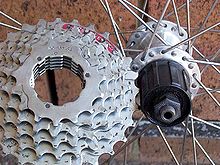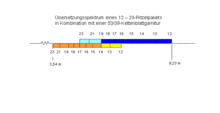Ring gear package
As sprocket assembly or sprockets , even cassette is referred to the rear part of the drive for a bicycle with derailleur . The ring gear pack is detachably connected to the rear wheel hub .
Types
There are basically two types of construction:
The freewheel was common until the early 1990s. The rims are screwed onto the hub and form a compact unit with the freewheel .
The cassette or the plug-in collar is placed on a freewheel body that is screwed to the hub and fixed with a locking ring. Because of their advantages, they have supplanted freewheels since their introduction in the 1990s.
With many cassettes - especially in the racing bike sector - the individual sprockets can be exchanged, as they are not firmly connected to one another ( screwed with Allen screws or completely loose). In some packages, they are riveted, form a unit and can only be changed completely. The exchange is quick and fewer assembly errors can be made. The sprocket set is fixed with a chain whip during dismantling, otherwise the freewheel will rotate with it.
Translation and size
If one describes the number of teeth of the smallest and the largest gear rim , one speaks of the capacity of the package. Cassettes for racing bicycles have a low capacity and therefore only minor differences in the number of teeth on adjacent sprockets, i.e. very small gear steps. With mountain bikes, on the other hand, a large capacity is important, which is achieved through larger gear steps. The smallest built-in rims have 10 teeth, the largest up to 32 (racing bike) or 50 (mountain bike SRAM Eagle).
Since the cassettes are usually combined with a chainring set of two or three chainrings , there are overlaps in the middle gear ratio range, within which one can choose between approximately or even exactly the same gear ratios. This is an advantage in hectic racing situations, as a double gear change is not always necessary or a suitable time can be selected for this (see illustration).
For chain gears, instead of the usual 1/2 ″ × 1/8 ″ bicycle chain (outer width around 9 mm) with a chain lock, special, narrower chains are required:
- 1/2 ″ × 3/32 ″ for packages with up to 8 sprockets (outer width 7.1 to 7.3 mm depending on the manufacturer, 8 mm for older five-speed gears)
- 1/2 ″ × 11/128 ″ for packages with up to 9 sprockets: Shimano-HyperGlide (outer width 6.8 mm) and Campagnolo (outer width 6.6 mm)
- 1/2 ″ × 5/64 ″ for packages with up to 10 sprockets: Shimano-HyperGlide (outer width 6.15 mm) and Campagnolo (outer width 5.9 mm)
- 1/2 ″ × 9/128 ″ for packages with up to 11 sprockets: Campagnolo (outer width: 5.5 mm)
photos
literature
- Fritz Winkler, Siegfried Rauch: Bicycle technology repair, construction, production . 10th edition, BVA Bielefelder Verlagsanstalt GmbH & Co. KG, Bielefeld, 1999, ISBN 3-87073-131-1







